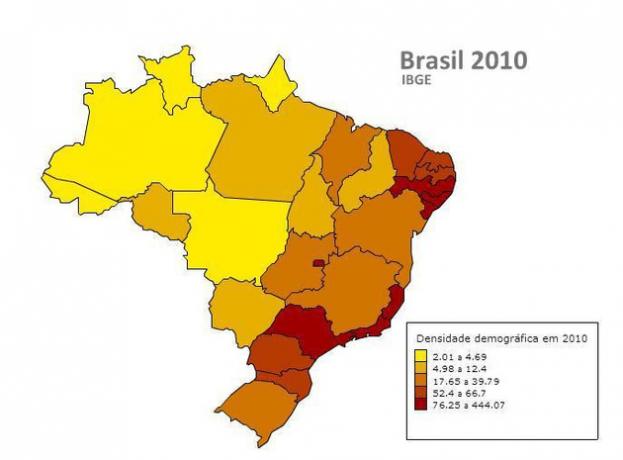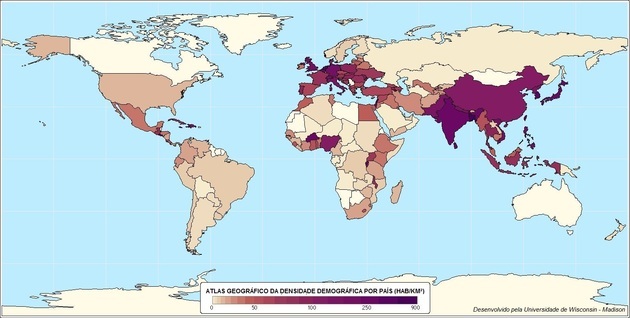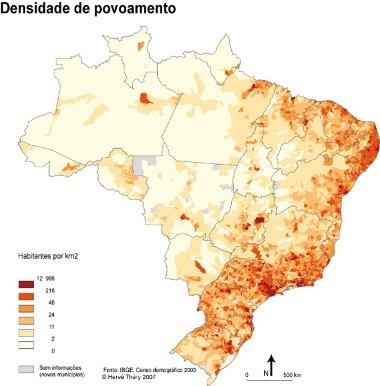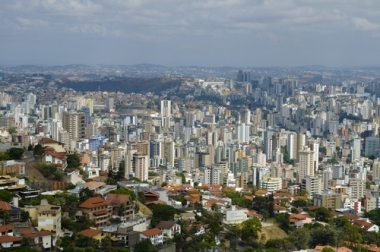Demographic density, also called population density or relative population, is a term used in geography to indicate how many people live per square kilometer.
It is by the demographic density that we can tell if an area is heavily or sparsely populated.
Demographic Density in Brazil
According to IBGE estimates for 2020, the country has approximately 211.8 million inhabitants and most of the Brazilian population is concentrated in the Southeast, South and Northeast regions.

On the map, it is possible to observe that the greatest concentration of the population occurs in coastal regions. The highest population density in the country is found in Rio de Janeiro (365.23 inhabitants per km2) and São Paulo (166.25 inhabitants per km2), according to 2010 data.
The highest population density, according to IBGE, is in Paraisópolis, in the State of São Paulo. There are 45,000 people sharing 1 km2.
In second place is the Rocinha favela, in Rio de Janeiro, with 39 thousand people per km
2. Also in Rio de Janeiro are Parque União and Nova Holanda, where 35,000 people share 1 km2.IBGE data in 2020 estimate that the Brazilian population is 211,755,692 people and the territory of Brazil corresponds to 8,510,345,538 km². Thus, the demographic density would be 24.88 inhabitants per square kilometer or 24.88 inhab/km2.
Therefore, evenly distributing the population across the territory, we would have approximately 25 people per square kilometer. However, we know that in reality there is a large concentration of people on the coast and the interior is less populated.
How to calculate population density?
To find the demographic density of an area, we use the following formula:
Where,
DD = population density
PT = total population
THE = total area of the region/country
Example:
The Brazilian population is approximately 211.8 million inhabitants and the territory of Brazil is about 8.5 million km2. Therefore, the demographic density is equal to 24.88.
An area can have high or low population density rates due to the following factors:
- Climate
- Urbanization
- Offer of fertile land
- Rainfall distribution regime
- Offer of jobs
- Wars, epidemics, etc.
Demographic Density in the World
According to data from the World Bank, the population density in the world is 50.79 people per km2. The result considers the planet's area of 510 million km2 and the population, estimated at 7.3 billion inhabitants.
See the demographic density of the five continents in the table below:
| Continent | Demographic density |
|---|---|
| Asia | 137.3 inhab./km2 |
| Africa | 38.4 inhab./km2 |
| Europe | 32.24 inhab./km2 |
| America | 23.5 inhab./km2 |
| Oceania | 4.6 inhab./km2 |
Observe the world demographic density on the map below:

We clearly perceive that the Asian continent has the highest rate of population density.
We must not forget that demographic density is not about population size but about territory.
The China that has the largest number of inhabitants is not the country that has the highest rate of population density because its territory is immense.
Thus, the country with the highest rate of population density is Monaco, with a territory of 2.2 km2 for a population of 38 499 inhabitants, according to 2016 data. Thus, its demographic density is 15,102.97 inhab./km2.
read more:
- Demography
- Demographic Theories
- Population growth



